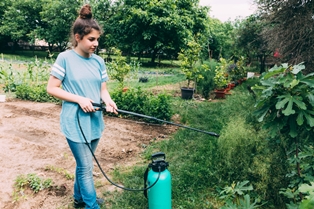Maintaining a lush, green lawn is a goal for many homeowners, and one key aspect of achieving this is proper fertilization. Fertilizing your lawn provides essential nutrients that promote healthy grass growth, but the question remains: How often should you fertilize your lawn? Let’s explore the factors that influence the frequency of lawn fertilization to help you achieve the vibrant and thriving lawn you desire.
Grass Type Matters:
The type of grass in your lawn plays a crucial role in determining the fertilization schedule. Warm-season grasses, such as Bermuda, Zoysia, and St. Augustine, have active growing periods during the warmer months. These grasses typically benefit from fertilization every 6-8 weeks during the growing season, which is spring through early fall.
On the other hand, cool-season grasses, including Kentucky Bluegrass, Fescue, and Ryegrass, thrive in cooler temperatures and have peak growing periods in spring and fall. For these grasses, it’s recommended to fertilize in early spring and again in late fall, with a possible third application in late summer if needed.
Soil Type and Condition:
Understanding your soil type is another crucial factor in determining how often you should fertilize. Soil composition affects nutrient retention and availability to the grass. Sandy soils tend to drain quickly and may require more frequent fertilization, while clay soils retain nutrients better, necessitating a less frequent schedule.
Conducting a soil test can provide valuable insights into your soil’s nutrient levels and pH, helping you tailor your fertilization plan to meet the specific needs of your lawn.
Fertilizer Type and Composition:
The type of fertilizer you choose also influences the frequency of application. Fertilizers come in various formulations, such as quick-release and slow-release. Quick-release fertilizers provide an immediate burst of nutrients but may require more frequent applications. In contrast, slow-release fertilizers deliver nutrients gradually over an extended period, reducing the need for frequent applications.
Choosing a balanced fertilizer with a combination of nitrogen, phosphorus, and potassium ensures your lawn receives a well-rounded nutrient supply. Be sure to follow the manufacturer’s recommendations for application rates to avoid over-fertilizing, which can harm the grass and contribute to environmental pollution.
Environmental Conditions:
Environmental factors, such as rainfall and temperature, also impact the frequency of lawn fertilization. If your region experiences regular rainfall, it may reduce the need for additional watering after fertilizing. In drier climates, supplemental irrigation is essential to activate the fertilizer and ensure proper nutrient absorption by the grass.
Additionally, extreme temperatures can affect the effectiveness of fertilizers. It’s advisable to avoid fertilizing during heatwaves or extended periods of drought, as the grass may be stressed and less responsive to the nutrients.
FAQs About How Often Should You Fertilize Your Lawn
A: The frequency of lawn fertilization depends on factors such as grass type, soil conditions, and the type of fertilizer used. In general, a common schedule is every 6-8 weeks during the growing season for warm-season grasses and 2-4 times a year for cool-season grasses. However, it’s crucial to tailor the frequency to your specific lawn’s needs based on factors like soil type and climate.
A: The best months to fertilize your lawn depend on the type of grass you have. For warm-season grasses, the ideal time is in late spring to early fall, during their active growing season. Cool-season grasses benefit from fertilization in early spring and late fall, avoiding the extreme temperatures of summer and winter.
A: Neglecting to fertilize your lawn can lead to nutrient deficiencies, resulting in poor grass health, thinning, and a lackluster appearance. Over time, the soil may become depleted, hindering the grass’s ability to resist pests, diseases, and environmental stress. Regular fertilization is essential to replenish nutrients and promote a vibrant, healthy lawn.
A: A good fertilizer schedule is determined by factors like grass type, soil conditions, and climate. For warm-season grasses, a schedule of every 6-8 weeks during the growing season is typical, while cool-season grasses benefit from applications in early spring and late fall. Conducting a soil test can help customize the schedule based on your lawn’s specific nutrient needs.
A: Fertilizing your lawn every 4 weeks may be excessive and could lead to over-fertilization, harming the grass and contributing to environmental issues. It’s important to follow recommended application rates on the fertilizer packaging and consider factors such as soil type, grass type, and weather conditions. Over-fertilizing can result in nutrient imbalances and damage to the lawn.
A: The 20-20-20 rule refers to a balanced fertilizer formulation containing equal parts of nitrogen (N), phosphorus (P), and potassium (K). This balanced ratio provides a comprehensive mix of essential nutrients for plant growth. It is suitable for general-purpose use on lawns, flowers, and vegetables. When using this fertilizer, follow the recommended application rates to avoid over-fertilization and ensure optimal results for your plants.
Conclusion:
There is no one-size-fits-all answer to the question of how often you should fertilize your lawn. It depends on factors like grass type, soil conditions, fertilizer type, and environmental considerations. Developing a customized fertilization schedule based on these factors will help you achieve a vibrant, healthy lawn that enhances the curb appeal of your home. Regular monitoring, soil testing, and adherence to recommended application rates are key practices for a successful lawn fertilization regimen.






